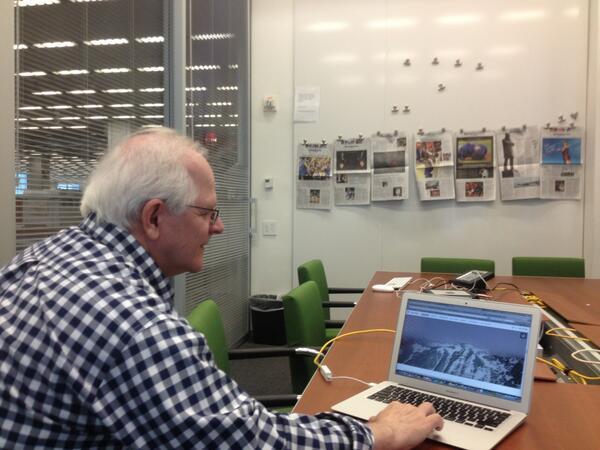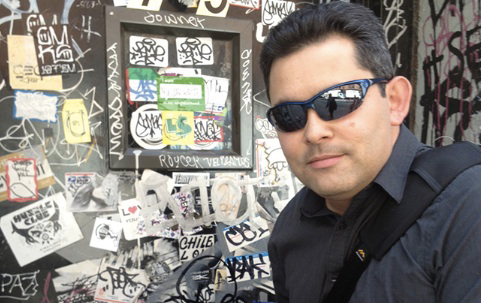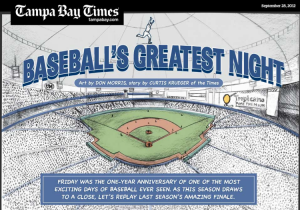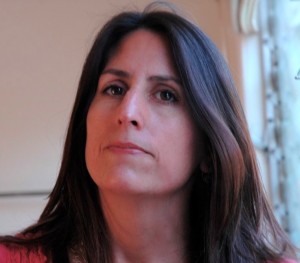Category Archive: Journovator Interviews

#JournovationTour NYC Stop 1: The New York Times – Snow Fall
May 20, 2013
This is part of a five-part report on my summer #JournovationTour of innovative digital journalism outfits and startups. The first stop on my tour was The New York Times.
In April at ISOJ, I heard a talk about Snow Fall by New York Times graphic artist Hannah Fairfield, and I wanted to learn more about how that groundbreaking package was put together so that we as journalism educators can guide students in that direction. She connected me with sports graphics editor Joe Ward (pictured above) and programmer Jacky Myint, who did all of the Jquery programming that made it possible.
There are a lot of things about Snow Fall that make it an example of great digital journalism, but what struck me most was two things: 1) the way in which the interactive elements pull you through and, in the style of a good novel, remove the fatigue that sets in with some long-form pieces; and 2) the degree of integration between the text and interactive elements. You can see examples of both in the chapter, The Descent Begins.
As you scroll down the page, you eventually get to a graphic of a mountain. As each skiier’s experience is described in the story, the person’s name is highlighted and you see the skiier’s path down the mountain.
Being semi-tech myself, I asked Jacky how this was accomplished without relying on something like Flash. It turns out that she once specialized in ActionScript, which she learned while earning a Masters in Fine Arts from Parsons, but as Flash went out of style she refocused on HTML, CSS and JQuery. Many of the scroll-based effects in Snow Fall are coded in Jquery using the Reel.js plugin. Commonly used in advertisements, the Reel.js plugin is described as an alternative to Flash and Java for creating 360-degree object movies, vistas and panoramas.
I know that’s a lot of geekspeak. For what it’s worth, I’ve asked Jacky if she can provide some easy tips for journalists who aren’t hard-core programmers who want to create their own scroll-based events and stories like this. She hasn’t answered yet so I take that as a sign that I’m oversimplifying the question. In other words, to do something like this you really need to work side by side with an experienced JQuery programmer.
And that gets to the much more interesting and actionable takeaway. The reason Snow Fall is an integrated experience is because not a single word was written before an interdisciplinary team was brought together, according to Joe Ward. “Designers were brought in very early,” Ward told me. “John Branch interviewed everyone in the story, came back and said ‘we have a lot of good stuff here.’ We got together and agreed, ‘Let’s not make it a story with lots of multimedia options. Let’s make it as seamless as possible.’ ”
And that’s exactly what they did.
But there’s another interesting back story to what made that decision easier. There used to be three departments, Graphics, Multimedia and Interactive News, with overlapping focus, and they sometimes competed for attention and resources. After one department disappeared due to the departure of a team member, the programmer was suddenly working side by side with a 3D animator and the traditional organizational barriers to collaboration disappeared.
Putting internal collaboration ahead of competition is the key lesson from Snow Fall. As Ward said, “No one person on the team could have done this story. It required all of us.”
So you hear that, digital news editors? Get your disparate teams together at the beginning of a story, not the end. Maybe even combine departments or, at the very least, create interdisciplinary teams that are ready to jump on a big story from day one. Otherwise you will end up with something like this whimsical example from the Time’s Aaron Pilhofer of how Snow Fall would have looked without an integrated approach. Or you’ll produce a nice, but not very interactive, video like the Times’ Punched Out.
Those are my takeaways from the New York Times visit. Thank you to Joe Ward and Jacky Myint for taking time out of their busy schedules to talk with me. I know our students at Newhouse would love to hear more!

Report from Dan Pacheco’s #JournovationTour in New York City
May 20, 2013
I just returned from a fast-paced tour of startups and journalists in New York City that are each shaking up the world of journalism in their own ways. I live-tweeted whenever possible using the hashtag #JournovationTour, and also took notes as I went along. This is a report from that trip.
Just for fun I wrote this in Spundge Pro, one of the startups I met along the way that I’m now evaluating for future use by students at the S.I Newhouse school. I just finished my first year as the Newhouse Chair of Journalism Innovation and will be co-teaching the class that feeds into the award-winning student-produced Newshouse site started by Jon Glass.
The five stops on my tour were:
- The New York Times, with the team that created Snow Fall.
- Marquee, a spunky little startup that powers the storytelling engine for Narrative.ly, now on Time’s 50 Best Websites list.
- Twitter, which recently hired Mark S. Luckie as an evangelist and trainer of journalists via Twitterfornews.
- Kickstarter, which as become a new way for journalists and media projects to get new projects and even companies funded.
- Spundge, a hybrid blog search, RSS reader, social media curator and publishing tool.
I realized going in that this was a broad and varied group of subjects, but that was also the point. I wanted to talk to a variety of people in organizations big and small to show students of journalism how their field is being shaped from all corners — not just the legacy organizations, but also from startups. And if my small sampling from New York City is any indication, there’s plenty of change, disruption and opportunity ahead for journalists.
My colleague, multimedia journalist and Professor Corey Takahashi, came long to some of the meetings and saw a couple common threads:
@pachecod Thinking back, there was a common theme to the tech cos: Each said they wanted to get out of the way of great content, creators.@pachecod Thinking back, there was a common theme to the tech cos: Each said they wanted to get out of the way of great content, creators.
— Corey Takahashi (@takalabtime)
May 17, 2013
I will agree with that, and also add that journalists in larger organizations are trying to get out of each others’ way, and to remove artificial barriers to collaboration.
Over the coming days I will be publishing each stop as its own article, then link them all together as one package. Start by reading my report from stop 1 at The New York Times.
Looking ahead, this is what I hope to be just the first part of a multi-city tour that I take through this summer, with other locations including Washington, D.C. and possibly Chicago. Want to meet me on the next leg of the tour? Let me know via @pachecod or @JournovationSU on Twitter or fill out our contact form.
Journovator spotlight: The Bly Project
November 15, 2012
Our latest Journovator Spotlight falls on a group featuring a pair of our own graduates from the Newhouse School – The Bly Project. We caught up with the founders at Spot Coffee in Rochester. You can watch the interview here (apologies for the coffee making in the background).
[youtube]http://youtu.be/u-FabIVzMr0[/youtube]
About The Bly Project
The Bly Project is Leah Stacy, Pete Wayner and Kevin Kennedy. Leah and Pete received their masters’ degrees from Syracuse – Leah was an arts journalism major, Pete was a magazine, newspaper and online journalism major. The three created The Bly Project, which they describe as “immersion travel journalism for social good.”
To get things moving, they created a pitch on Kickstarter that attracted $3,895 from 92 backers. They then used those funds to travel across the country, starting from their home in Rochester, N.Y. and culminating in Austin, Texas. They interviewed people along the way about what the American Dream means to them and compiled them into a series of multimedia stories that you can read on The Bly Project site.
Comic book sports coverage: Journovation interview with Don Morris
October 15, 2012
One of the neatest things I’ve seen in the sports pages lately came last month in the Tampa Bay Times. To commemorate the one-year anniversary of the end of the 2011 baseball season – in which the Tampa Bay Rays clinched a dramatic playoff berth on the last day of the season – the Times retold the story of that day in comic book form.
I interviewed Don Morris, who drew the comic book, about the project via email:
Where did the idea for a comic book narrative come from?
I’m a big fan of comic narratives and have been looking for an opportunity to do one in our own paper. I have always done journalistic sketchbooks to report everything from the Super Bowl in Tampa to hurricane evacuation centers at the height of storms. A comic narrative to me was the perfect next step to retelling a news event in a dramatic and fun way. Problem has always been getting the time to do this.
When this idea first came up, what was your first reaction?
I brought the idea of doing a comic narrative for Game 162 with my good friend Curtis Krueger, a writer friend of mine at the Times. His beat is courts, but he is a big Rays fan. We started talking about this for a year ago about a week after the historic game. When spring training came around in March, we wanted to do it in our annual Rays season preview section. Problem was it was a look back – not a look forward, duh. So we aimed for the All Star break, but I couldn’t get the time to sketch due to some special projects, vacation and the usual news events that keep us from doing these types of enterprise projects.
What about this story lent itself to being told in this format?
1. The biggest reason is that Game 162 was called the greatest regular season game ever played by baseball experts throughout the sports world. That made this an iconic event, especially to Rays fans immediately.
2. I listened to the game by radio because I couldn’t be near a TV. As a result, I pictured the whole game the way I used to when I was a kid. It made the game all the more memorable to me. The experience of listening by radio made the game take on a legendary feel to me right away. I grew up reading sports comics in the newspaper so I knew this would be a fun game to recreate with comics. It also would help me connect visually to the game.
3. Besides the breaking news and follow-up coverage of this amazing game and all the visuals that go along with that, highlights from the game were rehashed countless times throughout the year by the Rays organization and our own local media. This was another way to retell the story in a way fans could reconnect and celebrate anew on the one year anniversary.
What was the drawing process like?
Once we had a storyboard, the drawing part was fun – even with lots of pressure. Storyboarding is crucial because it allows the script and drawings to “dance” as one. By having the storyboard, I knew exactly what I was looking for in reference and what I wanted to do on the pages. Believe me, it’s not fun to sit down at a drawing board without a plan and even worse to get done and have to go back to redraw! The drawing process for this project was highly pressurized because I had only a week and a half to do all drawings and get them on the page so text could be refined and of course go through all editing stages.
What’s the reaction to this been like, both inside and outside the newsroom?
The reaction has been enthusiastic in the community and our newsroom. The online version was published on the Friday before it appeared in our Sunday paper and shared hundreds of times on Facebook. We overprinted the section and distributed it at the last game of the season to fans at the game. I have to admit, I was surprised at how surprised my Times colleagues were to see this type of storytelling in our newspaper. We have always prided ourselves at our willingness to tell stories in unconventional ways.
Was there any thought into making this an interactive story?
In the very beginning, we fancied making this an e-book and including video clips and audio interviews. That is our goal for the next time we do this.
What did you learn from doing this?
This reconfirmed to me that even with a very short period of time to produce something like this, it’s possible when everyone buys in on an idea and clears the deck to make its completion possible. This project reinforced for me how special The Tampa Bay Times is as a place for telling stories in unconventional ways.
Are you a comic book fan? If so, what’s your favorite?
I’m not so much a comic book fan as I am a fan of illustrated stories. If it’s a good story and it’s illustrated and designed in a compelling way I love it. It doesn’t matter whether it’s in a book, magazine, newspaper or online. My favorite right now is Josh Neufeld’s “New Orleans After the Deluge” (Pantheon Books).
Repost.us: a New Model for Networked Journalism
October 3, 2012
My favorite innovations are the ones that are so easy and obvious that you hit yourself in the head every morning asking yourself, “why didn’t I think of that?” Repost.us is in that camp.
Repost.Us’ founder John Pettitt, also co-founder of e-commerce company Cybersource and career networking company Beyond.com, calls Repost.Us “Syndication in the 21st century.” He explains it this way: “If you see an article and want to repost it on another site, you have to find a human being and find out if you can do it. And that’s so last-century … there’s a better way. The video world has the embed. Why can’t you embed an entire article?”
[youtube]https://www.youtube.com/watch?v=lj6l-hHCh6I[/youtube]
He has a point. A huge part of the blogosphere consists of sloppy rewrites and citations of other peoples’ content, usually (but not always) followed by a link to the full story on the originating site. These links are helpful to the content creators because it helps their SEO in Google, and also gets them a few more ad impressions for people who click through, but the click-through to those links is not terribly high.
As a result, a whole generation of content companies have emerged in recent years to aggregate, curate and make money off content that they simply found, but didn’t pay to create. For investigative journalism this is particularly problematic because the cost of those stories is never covered by the ads to the few readers who click into the original story.
This is where RepostUs shines. When you go to a site that carries the RepostUs code and try to copy a chunk of text, you see a friendly popup telling you that you can embed the entire article — a prospect that is actually better and easier than simply including a quote in your own post. You copy the embed code just like in YouTube, plop it into your blogging software and the entire contents of the article are included on your own site with branding of the originating site.
But the real power is that it also carries the advertising and analytics code of the originating site. This is where I smack myself on the head every time. Of course! This is a total game-changer for the hard-working journalist or blogger in many ways. (I know that Jeff Jarvis at CUNY, who exitedly told me about RepostUs the minute I saw him at the Online News Association conference, agrees).
- First, it provides a financial incentive for them to encourage people to “rip off” their content. Why? Because it increases the audience for their advertisers.
- Second, it also increases the total traffic to their site, because now they’re getting credit for the other places where their article appears.
- Third — and this is the most interesting part — it redefines the entire nature of brands online. If embedding articles becomes more common than linking to them (which is not hard to imagine, given the prevalence of embedded YouTube videos), what is a site anymore? And could you even go so far as to say “who cares about your web site?” What matters is that people are reading your content, and you’re getting credit and ad revenue from it. Does it really matter where people are reading it?
I’m so excited about RepostUs that I’ve enabled it on this site, so if you want to see how it works you can do it right now. Copy any chunk of text in this article and see what happens, then embed the content into your own site. You can see examples where I’ve done this on my personal blog at http://futureforecast.com/blog.
Now if you excuse me, I need to go repost this article on a dozen of my other sites!
-Dan Pacheco, Chair of Journalism Innovation, S.I. Newhouse School of Public Communications
Spotlight on Nonny de la Peña, Immersive Journalist
October 2, 2012
I first met Nonny de la Peña a few years ago through the Knight News Challenge. She’d just started her project Stroome, a collaborative video editing tool, and I was about to spin off my KNC project Printcasting into BookBrewer. Nonny is still running Stroome on the side, but has meanwhile taken up residence at the University of Southern California’s Annenberg as a fellow at the Cinematic Arts School.
[youtube]http://www.youtube.com/watch?v=LOaCT7Kts64[/youtube]I ran into her at the Online News Association conference in San Francisco and was happy to see that she’s still plugging along, but even I couldn’t predict how incredibly cool her latest project is. Using virtual reality goggles, she can project you into a news story with audio from the actual event, and an incredibly realistic virtual environment and avatars that move around you in real time. You can get a sense for how it works in the 5-minute video above, but you really have to experience it to understand how transformative it is. Rather than reading about an event, or watching it on a monitor, you’re actually in it and reacting along with the other virtual witnesses around you.
Nonny has big plans for this technology, including theaters where people can buy a ticket to “ride” through a news story. After entering her first immersive project, which is about a food bank that was running out of food while an elderly man suffered a diabetic seizure, I give a high probability of success to her assertion that enterprising journalists will make a lot of money off traveling immersive VR shows.
 She debuted her first project at the Sundance Film Festival, where she had 3-hour waiting lines and put 1,000 people through the experience. With interest like that, it’s not far-fetched to imagine a subset paying $10 each. Not only would that fund further development, but it would show that people will pay to walk a mile in someone else’s virtual shoes.
She debuted her first project at the Sundance Film Festival, where she had 3-hour waiting lines and put 1,000 people through the experience. With interest like that, it’s not far-fetched to imagine a subset paying $10 each. Not only would that fund further development, but it would show that people will pay to walk a mile in someone else’s virtual shoes.
Newspaper sites are putting up paywalls in the hopes of getting people to pay for news, with limited success. Should they be setting up virtual news centers in shopping malls and selling tickets instead?
– Dan Pacheco
Spotlight on Mark S. Luckie, Manager of Journalism and News for Twitter
October 1, 2012
We caught up with Mark S. Luckie at the Online News Association conference in San Francisco and asked him our standard five questions. Mark just signed on as Twitter’s first Manager of Journalism and News and is busy putting out all kinds of tips, research and data to help journalists use Twitter to enhance their work. Here’s what he told us.
[youtube]http://www.youtube.com/watch?v=oN403vzLcjI[/youtube]
Journovator spotlight: Jake Naughton
September 17, 2012
Jake Naughton, the multimedia projects coordinator for The Pulitzer Center, spoke with Brian Moritz on Sept. 13 about his work creating digital journalism books.
[youtube]http://youtu.be/-ieEkbbw6Ds[/youtube]
Naughton discussed how The Pulitzer Center is creating books of original reporting that can be read on an iPad using the iBooks Author software. We talked about how these books can become multimedia projects and how they can help news organizations find new audiences.
The video runs about 20 minutes.
For more info on these books, visit The Pulitzer Center .
Journovator spotlight: Steve Buttry
September 17, 2012
Steve Buttry, an experienced digital journalist, joined Dan Pacheco’s “Creating the Next News Start-Up” class on Sept. 11 via Google+ Hangout.
[youtube]http://www.youtube.com/watch?v=EP2vxLRcuCM&feature=plcp[/youtube]
Steve, who works as Digital Transformation Editor for Digital First Media and Journal Register Company, spoke with the class about the changes going on within the newspaper industry as the print-to-online shift continues. He discussed his work online and in print and what the future holds for journalism.
The video runs about an hour and 20 minutes.
For more of Steve’s thoughts, visit his blog.
Journovation spotlight: Homicide Watch D.C.
September 17, 2012
There are at least two types of journalism innovations we’re interested in studying. There are the technical innovations that are changing the way news is gathered, the way news is delivered and the way news is consumed. And there are also conceptual innovations that are changing the way we as journalists view what is “the news.”
One site that is demonstrating both these types of innovations is Homicide Watch D.C.
Homicide Watch DC, which is run by Laura Amico and Chris Amico, covers every murder in Washington, D.C. The site covers every case, every step of the way, from murder to adjudication.
The site recently completed a successful Kickstarter campaign, raising more than $40,000 in a month. Because Laura Amico is on fellowship this academic year at Harvard (where she’s a Nieman-Berkman fellow), the site would have gone dark if they hadn’t raised enough money to pay for reporters to run the site during this year.
“Nobody wanted the site to go down,” Laura Amico said in a Google+ Hangout on Sept. 17. “No one in the community wanted it to go down. So we decided to turn it into a student reporting lab.”
The money raised will allow the Amico’s to hire at least five student interns to run the site this year. The campaign also raised the site’s profile, with David Carr writing about it in The New York Times and Clay Shirky writing an impassioned call for funding. “Homicide Watch matters because they are more than just thorough, they’re innovative,” Shirky wrote.
In several ways, Homicide Watch DC is re-conceptualizing what local journalism looks like in the digital world.
One of the most obvious is in its focus. Homicide Watch DC is intensely local and intensely focused. It works under the banner: “Mark every death. Remember every victim. Follow every case.” It’s a radically simple notion – the Amicos cover every murder in Washington D.C., every step of the way.
The approach was born out of Amico’s experience as a newspaper crime reporter and her own curiosity when she moved to Washington D.C. in 2009.
“I didn’t understand how the individual cases fit into a bigger narrative,” she said. “I didn’t know which ones fit in, and I thought I needed to get a handle on the 100s of cases. And that was a smart decision. It let us review the assumptions of which crimes are newsworthy.”
Those assumptions are built into the work routines of print and television journalists.
“I think TV media does some of the best crime coverage, especially here in DC,” Amico said. “But they’re looking for that good shot, that good scene. And if happened late at night and it’s cleaned up by morning, there’s no shot. For print, there are different requirements.”
For Homicide Watch, D.C., there are no requirements. There is no news judgement, no wondering if this is worthy a story or not. If it’s a homicide it’s covered. Same as every other one.
To do so brings in the technological innovation – a database that is the site’s engine. The database allows the Amicos to follow each case, to collect data on every murder in Washington and to publish that information as they receive it. This information, which is often gathered piecemeal as it comes in, goes into the database.
“As I’m reporting on a case, I can fill in the location, the age, whatever,” Amico said. “So when, say, it’s Monday morning, there were three murders of the weekend, is that a lot? Or if I want to go deeper – who was killed this year, or are there a lot of plea deals vs. verdicts, I can do all of that with our database.”
The technological aspect of the site highlights another innovative approach the Amico’s take to their site. The site isn’t built around stories in the way that newspapers are or traditional news organizations are. It’s built around the database. Stories are a part of that and come out of that. But the crux of the site is the information, not the story.
“I love to write, I became a journalist because I love to write, and when I look at some of the things on Homicide Watch, I think ‘This isn’t all great writing,'” Amico said. “It’s a lot more about the information and being a community resource than it is about great writing. Ideally, at some point, there ends up being a well-written story. But I don’t have to come back and write the 40-inch story the next day about it. At Homicide Watch, we can take the time we need to get there and to build narratives.”
That time also allows for one of Homicide Watch’s other conceptual innovations. It is built, in many ways, around the community it serves. Community members comment on stories, connect through email, social media and any other way you can imagine. The site shows that being a news organization is as much about being a community resource than it is about being a reporting center.
This comes through in how Amico deals with the victims’ families.
“When I worked as a traditional reporter, you’d go out to a crime scene and you were not allowed to come back without “The Quote,” she said. “The way we do things now, I don’t need that quote immediately. If their mother or brother would rather not say something to me right now, if they’re not ready to talk, I don’t want to force them to. Instead, I’ll give them my card and tell them I’m doing a story for tomorrow, if you would like to say something, you can leave a comment on the story or here’s how to get in touch with me later, here’s my e-mail, my phone number. If you’d like to get in touch with me later, that’s fine.
It really puts the power in their hands.”




